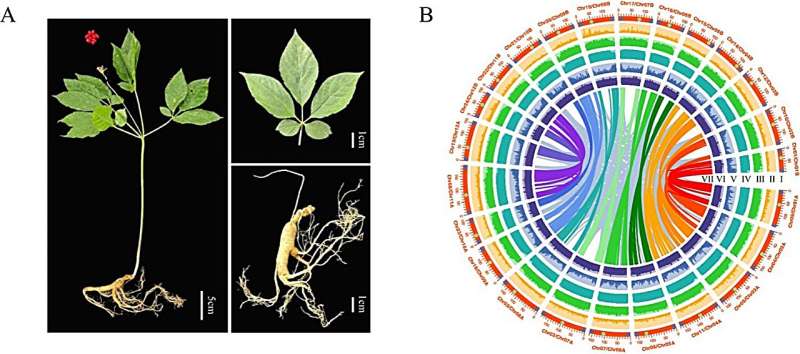This article has been reviewed according to Science X's editorial process and policies. Editors have highlighted the following attributes while ensuring the content's credibility:
fact-checked
peer-reviewed publication
trusted source
proofread
Ginseng's full genome sequenced

Ginseng's role in traditional medicine is underscored by its complex genetic structure due to its allotetraploid nature. A recent study delves into this complexity, revealing key evolutionary insights into its subgenomes that govern saponin biosynthesis—the primary active compounds in ginseng. This necessitates deeper genetic research to fully harness ginseng's medicinal potential.
Led by Nanjing Agricultural University, the study was published in the April 2024 edition of Horticulture Research.
Researchers meticulously constructed a complete 3.45 Gb genome of Panax ginseng, identifying 77,266 protein-coding genes and focusing on the pathways and biosynthesis of ginsenosides—crucial for the plant's medicinal properties. This work significantly enhances the understanding of ginseng's biological complexities and its therapeutic potentials.
Researchers in this study have intricately mapped ginseng's genome, identifying asymmetrical gene loss and biased gene expression across its subgenomes, dating their divergence to about 6.07 million years ago.
The analysis highlights extensive gene family expansions linked to saponin biosynthesis and underscores the importance of specific gene duplications in enhancing these pathways.
Comparative genomic analysis with related species provides further insight into the evolutionary tactics ginseng employs to optimize its medicinal benefits. This research not only deepens our comprehension of the ginseng genome but also establishes a crucial resource for future genetic research and the development of enhanced breeding programs.
Dr. Wei Li, the study's senior researcher, states, "This complete assembly of the ginseng genome is a monumental achievement in botanical research. It not only broadens our understanding of the genetic intricacies of medicinal plants but also introduces refined methods for cultivating ginseng varieties with superior health properties."
The comprehensive decoding of the ginseng genome sets the stage for precise breeding techniques aimed at boosting its medicinal efficacy.
This research not only has immediate applications for enhancing ginseng cultivation but also serves as a model for investigating other medicinal plants, potentially revolutionizing pharmacology and crop enhancement strategies with natural products.
More information: Yiting Song et al, Telomere-to-telomere reference genome for Panax ginseng highlights the evolution of saponin biosynthesis, Horticulture Research (2024). DOI: 10.1093/hr/uhae107
Journal information: Horticulture Research
Provided by NanJing Agricultural University



















